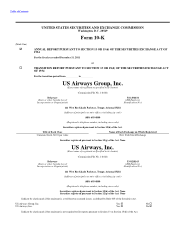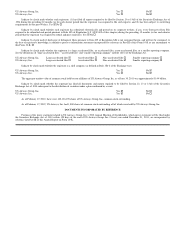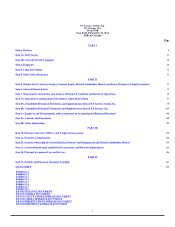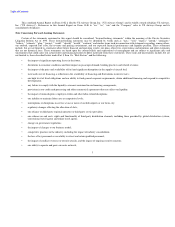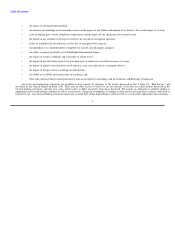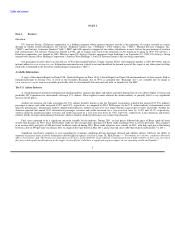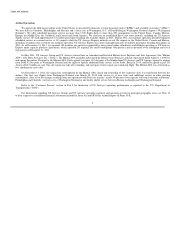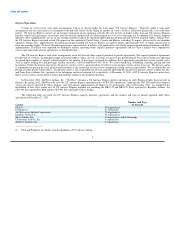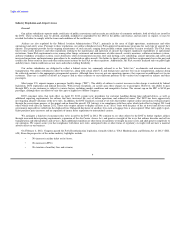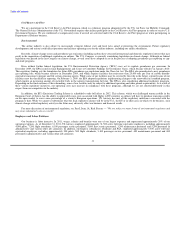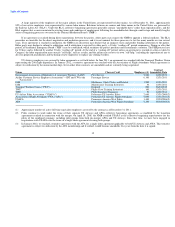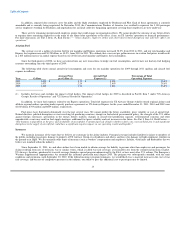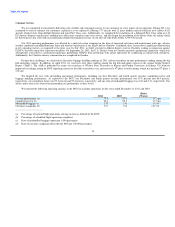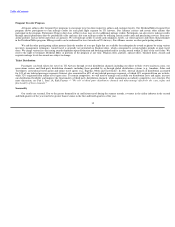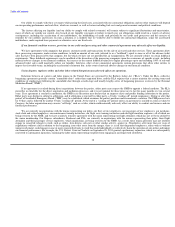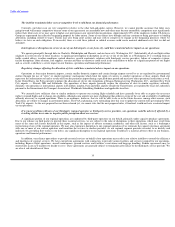US Airways 2011 Annual Report Download - page 12
Download and view the complete annual report
Please find page 12 of the 2011 US Airways annual report below. You can navigate through the pages in the report by either clicking on the pages listed below, or by using the keyword search tool below to find specific information within the annual report.
Table of Contents
Industry Regulation and Airport Access
General
Our airline subsidiaries operate under certificates of public convenience and necessity or certificates of commuter authority, both of which are issued by
the DOT. These certificates may be altered, amended, modified or suspended by the DOT if the public convenience and necessity so require, or may be
revoked for failure to comply with the terms and conditions of the certificates.
Airlines are also regulated by the Federal Aviation Administration ("FAA"), primarily in the areas of flight operations, maintenance and other
operational and safety areas. Pursuant to these regulations, our airline subsidiaries have FAA-approved maintenance programs for each type of aircraft they
operate. The programs provide for the ongoing maintenance of such aircraft, ranging from periodic routine inspections to major overhauls. The FAA from
time to time issues directives and other regulations relating to the maintenance and operation of aircraft that require significant expenditures or operational
restrictions. Some FAA requirements cover, among other things, retirement and maintenance of older aircraft, security measures, collision avoidance systems,
airborne windshear avoidance systems, noise abatement, other environmental concerns, fuel tank inerting, crew scheduling, aircraft operation and safety and
increased inspections and maintenance procedures to be conducted on older aircraft. Our failure to timely comply with these requirements has in the past and
could in the future result in fines and other enforcement actions by the FAA or other regulators. Additionally, the FAA recently finalized rules on pilot flight
and duty times, which could increase our costs and reduce staffing flexibility.
Our airline subsidiaries are obligated to collect a federal excise tax, commonly referred to as the "ticket tax," on domestic and international air
transportation. Our airline subsidiaries collect the ticket tax, along with certain other U.S. and foreign taxes and user fees on air transportation, and pass along
the collected amounts to the appropriate governmental agencies. Although these taxes are not our operating expenses, they represent an additional cost to our
customers. There are a number of efforts in Congress and in other countries to raise different portions of the various taxes imposed on airlines and their
passengers.
Most major U.S. airports impose a passenger facility charge ("PFC"). The ability of airlines to contest increases in this charge is restricted by federal
legislation, DOT regulations and judicial decisions. With certain exceptions, air carriers pass these charges on to passengers. However, our ability to pass
through PFCs to our customers is subject to various factors, including market conditions and competitive factors. The current cap on the PFC is $4.50 per
passenger, although there are efforts to raise the cap to a higher level before Congress.
DOT consumer rules, that took effect on April 29, 2010, require new procedures for customer handling during long onboard delays, as well as
additional reporting requirements for airlines that have increased the cost of airline operations and reduced revenues. The DOT has been aggressively
investigating alleged violations of the new rules. In addition, the DOT finalized a second set of rules that further regulate airline interactions with passengers
through the reservations process, at the airport and on board the aircraft. US Airways is in compliance with these rules which took effect in August 2011 and
others which took effect in January 2012. These rules require airlines to display all fares in an "all in" basis with the price of the air travel and all taxes and
government imposed fees rolled into the displayed fare. Enhanced disclosure of ancillary fees such as baggage fees is also required. Other rules apply to post-
ticket purchase price increases and an expansion of tarmac delay regulations to international carriers.
We anticipate a third set of consumer rules to be issued by the DOT in 2012. We continue to see other efforts by the DOT to further regulate airlines
through increased data reporting requirements, expansion of the Air Carrier Access Act, and greater oversight of the ways that airlines describe and sell air
transportation and other products and services. Each additional regulation or other form of regulatory oversight increases costs and adds greater complexity to
our operation. We cannot assure you that compliance with these new rules, anticipated rules or other forms of regulatory oversight will not have a material
adverse effect on our business.
On February 6, 2012, Congress passed the FAA Reauthorization legislation, formally titled as "FAA Modernization and Reform Act of 2012" (H.R.
658). From the perspective of the airline industry, highlights include:
• No increase in airline ticket or fuel taxes;
• No increase in PFCs;
• No taxation of ancillary fees and revenue;
9


